F-104 Starfighter
The "piloted missile" by Gio
V1.5
F-104C now is compatible with drogue aerial refuel
FM/Java fixes
V1.4
AI bounce bug fixed
fix bug of plane stopped in the air when turn off engine
loadout bug fix
patch 1.3
fixed airbrake drag, now is more accurate
fixed behaviour at high G turns
Version 1.2
- Fix cannon Bug in F-104G
- New variants F-104J and CF-104
- New FM, more accurated
WikiClarence "Kelly" Johnson, the chief engineer at Lockheed's Skunk Works, visited Korea in December 1951 and spoke with fighter pilots about what sort of aircraft they wanted. At the time, the U.S. pilots were confronting the MiG-15 with North American F-86 Sabres, and many felt that the MiGs were superior to the larger and more complex American design. The pilots requested a small and simple aircraft with excellent performance. Armed with this information, Johnson immediately started the design of such an aircraft on his return to the United States. In March, his team was assembled; they studied several aircraft designs, ranging from small designs at 8,000 lb (3,600 kg), to fairly large ones at 50,000 lb (23,000 kg). In order to achieve the desired performance, Lockheed chose a minimalist approach: a design that would achieve high performance by wrapping the lightest, most aerodynamically efficient airframe possible around a single powerful engine. The engine chosen was the new General Electric J79, an engine of dramatically improved performance in comparison with contemporary designs. The small L-246 design powered by a single J79 remained essentially identical to the L-083 Starfighter as eventually delivered.
The design was presented to the Air Force in November 1952, and they were interested enough to create a General Operating Requirement for a lightweight fighter to replace the North American F-100. Three companies replied to the requirement: the Republic AP-55, an improved version of its prototype XF-91 Thunderceptor; the North American NA-212, which eventually evolved into the F-107; and the Northrop N-102 Fang, another J79-powered design. Although all were interesting, Lockheed had an insurmountable lead, and was granted a development contract in March 1953 for two prototypes, these were given the designation "XF-104".
Work progressed quickly, with a mock-up ready for inspection at the end of April, and work starting on two prototypes late in May. Meanwhile, the J79 engine was not ready; both prototypes were instead designed to use the Wright J65 engine, a licensed-built version of the Armstrong Siddeley Sapphire. The first prototype was completed by early 1954 and first flew on 4 March at Edwards AFB. The total time from contract to first flight was less than a year.
When the USAF revealed the existence of the XF-104, they only gave a vague description of it, similar to the secret F-117A in the 1980s. A drawing in the Popular Mechanics, August 1954 edition was very close to the actual design.
The prototype had hopped into the air on 18 February but that was not counted as a first flight. On the first official flight, it experienced landing gear retraction problems. The second prototype was destroyed a few weeks later during gun-firing trials but in November 1955 the prototype was accepted by the USAF.
Based on the XF-104 testing and evaluations, the next variant, the YF-104A, was lengthened and fitted with a General Electric J79 engine, modified landing gear and modified air intakes.
The first YF-104A flew on 17 February 1956 and with the other 16 trials aircraft were soon carrying out aircraft and equipment evaluation and tests. Modifications were made to the aircraft including airframe strengthening and a ventral fin was added. Problems were encountered with the J79 afterburner and delays were caused by the need to add Sidewinder missiles. On 28 January 1958 the first F-104A to enter service was delivered to the 83rd Fighter Intercepter Wing.
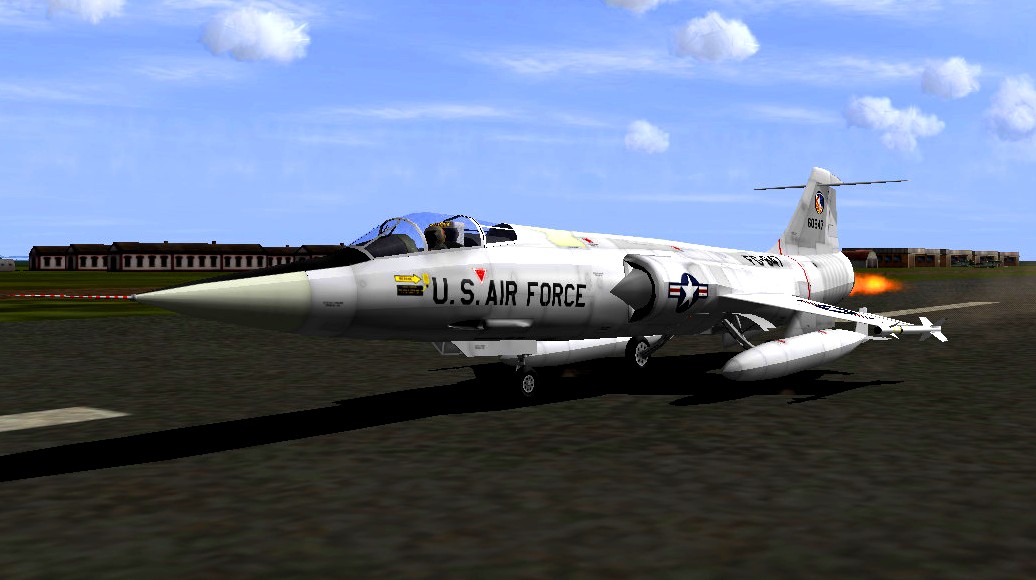
A total of 2,578 F-104s were produced by Lockheed and under license by various foreign manufacturers.
The F-104 featured a radical wing design. Most jet fighters of the period used a swept-wing or delta-wing. This allowed a reasonable balance between aerodynamic performance, lift, and internal space for fuel and equipment. The Lockheed tests, however, determined that the most efficient shape for high-speed, supersonic flight was a very small, straight, mid-mounted, trapezoidal wing. The new wing design was extremely thin, with a thickness-to-chord ratio of only 3.36% and an aspect ratio of 2.45. The wing's leading-edges were so thin .016 in (0.41 mm) that they presented a cut hazard to ground crews: protective guards had to be installed on the wing-tips during ground operations maintenance.
The thinness of the wings required fuel tanks and landing gear to be placed in the fuselage. The hydraulic cylinders driving the ailerons had to be only 1 inch (25 mm) thick in order to fit. The wings had both leading-and-trailing-edge flaps. The small, highly loaded wing resulted in an unacceptably high landing speed, so a boundary layer control system (BLCS) of blown flaps bleed air over the trailing-edge flaps to help lower landing speeds, making landings safer. The system proved to be a maintenance problem in service, and landing without the BLCS engaged could be a harrowing experience.
The stabilator (horizontal tail surface) was mounted atop the fin to reduce inertia coupling. Because the vertical fin was only slightly shorter than the length of each wing and nearly as aerodynamically effective, it could act as a wing on rudder application, rolling the aircraft in the opposite direction of rudder input. To offset this effect, the wings were canted downward, giving 10° anhedral.
The fuselage had a high fineness ratio, i.e. slender, tapered towards the sharp nose, and had a small frontal area. The tightly packed fuselage contains the radar, cockpit, cannon, fuel, landing gear, and engine. The fuselage and wing combination provided low drag except at high angle of attack (alpha), at which point induced drag became very high. The F-104 had good acceleration, rate of climb and potential top speed, but its sustained turn performance was poor.
The F-104 was designed to use the General Electric J79 turbojet engine, fed by side-mounted intakes with fixed inlet cones optimized for supersonic speeds. Unlike some supersonic aircraft, the F-104 did not have variable-geometry inlets. Its thrust-to-drag ratio was excellent, allowing a maximum speed well in excess of Mach 2.
Early Starfighters used a downward-firing ejection seat (the Stanley C-1), out of concern over the ability of an upward-firing seat to clear the "T-tail" empennage. This presented obvious problems in low-altitude escapes, and 21 USAF pilots including test pilot Capt. Iven C. Kincheloe, Jr. failed to escape from their stricken aircraft in low-level emergencies because of it. The downward-firing seat was replaced by the Lockheed C-2 upward-firing seat, which was capable of clearing the tail, but still had a minimum speed limitation of 104 mph (167 km/h). Many export Starfighters were later retro-fitted with Martin-Baker Mk.7 zero-zero ejection seats.
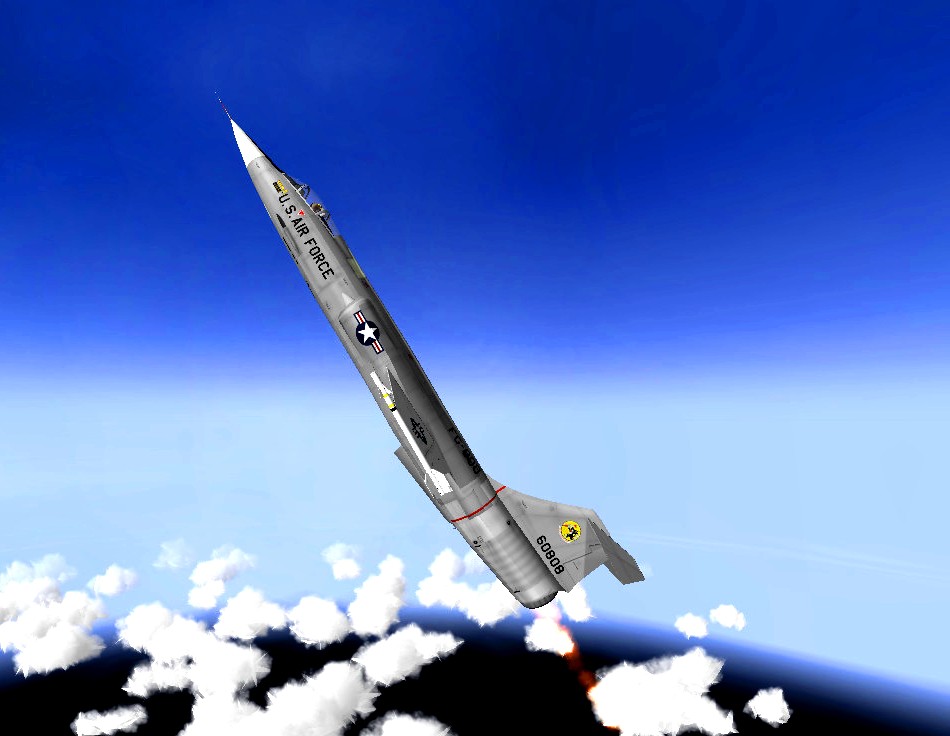
The initial USAF Starfighters had a basic AN/ASG-14T ranging radar, TACAN, and an AN/ARC-34 UHF radio.
In the late 1960s, Lockheed developed a more advanced version of the Starfighter, the F-104S, for use by the Italian Air Force as an all-weather interceptor. The F-104S received a NASARR R21-G with a moving target indication and a continuous-wave radar illuminator for semi-active radar homing missiles, including the AIM-7 Sparrow and Selenia Aspide. The missile-guidance avionics forced the deletion of the Starfighter's internal cannon. In the mid-1980s surviving F-104S aircraft were updated to ASA standard (Aggiornamento Sistemi d'Arma, or Weapon Systems Update), with a much improved, more compact FIAR R21G/M1 radar.
The basic armament of the F-104 was the 20 mm (.79 in) M61 Vulcan Gatling-mechanism autocannon. This weapon frequently had shell ejection problems due to linked ammunition resulting in avionic problems and crashes. A linkless ammunition feed system was developed for the upgraded M61A1 installed in the F-104C and later models. The Starfighter was the first aircraft to carry the new weapon, which had a rate of fire of 6,000 rounds per minute. The cannon, mounted in the lower part of the port fuselage, was fed by a 725-round drum behind the pilot's seat, giving only a continuous 7+ second burst of fire. It was omitted in all the two-seat models and some single-seat versions, including reconnaissance aircraft and the early Italian F-104S; the gun bay and ammunition tank were usually replaced by additional fuel tanks. The gun's location was advantageous as gun-flash was not in the pilot's line of sight, therefore not robbing him of night-adjusted vision. Two AIM-9 Sidewinder air-to-air missiles could be carried on the wingtip stations, which could also be used for fuel tanks. The F-104C and later models added a centerline pylon and two underwing pylons for bombs, rocket pods, or fuel tanks. The centerline pylon could carry a nuclear weapon; a "catamaran" launcher for two additional Sidewinders could be fitted under the forward fuselage, although the installation had minimal ground clearance and made the seeker heads of the missiles vulnerable to ground debris. The F-104S models added a pair of fuselage pylons beneath the intakes available for conventional bomb carriage. The F-104S had an additional pylon under each wing, for a total of nine
The F-104A initially served briefly with the USAF Air Defense Command / Aerospace Defense Command (ADC) as an interceptor, although neither its range nor armament were well-suited for that role. The first unit to become operational with the F-104A was the 83rd Fighter Interceptor Squadron on 20 February 1958, at Hamilton AFB, California. After just three months of service, the unit was grounded after a series of engine-related accidents. The aircraft were then fitted with the J79-3B engine and another three ADC units equipped with the F-104A. The USAF reduced their orders from 722 Starfighters to 155.After only one year of service these aircraft were handed over to ADC-gained units of the Air National Guard, although it should be noted that the F-104 was intended as an interim solution while the ADC waited for delivery of the Convair F-106 Delta Dart.
During the Berlin Crisis of 1961 President John F. Kennedy ordered 148,000 United States National Guard and reserve personnel to active duty on 30 August 1961, in response to Soviet moves to cut off allied access to Berlin. 21,067 individuals were from the Air National Guard (ANG), forming 18 fighter squadrons, four reconnaissance squadrons, six transport squadrons, and a tactical control group. On 1 November 1961, the USAF mobilized three more ANG fighter interceptor squadrons. In late October and early November, eight of the tactical fighter units flew to Europe with their 216 aircraft in "Operation Stair Step". Because of their short range, 60 F-104As were airlifted to Europe in late November, among them the 151st FIS and 157th FIS. The crisis ended in the summer of 1962 and the personnel returned to the United States.
The subsequent F-104C entered service with USAF Tactical Air Command as a multi-role fighter and fighter-bomber. The 479th Tactical Fighter Wing at George AFB, California, was the first unit to equip with the type in September 1958. Although not an optimum platform for the theater, the F-104 did see limited service in the Vietnam War. Again, in 1967, these TAC aircraft were transferred to the Air National Guard.
Commencing with the Operation Rolling Thunder campaign, the Starfighter was used both in the air-superiority role and in the air support mission; although it saw little aerial combat and scored no air-to-air kills, Starfighters were successful in deterring MiG interceptors.[16] Starfighter squadrons made two deployments to Vietnam, the first being from April 1965 to November 1965, flying 2,937 combat sorties. During that first deployment, two Starfighters were shot down by ground fire. One was shot down by a Shenyang J-6 when the F-104 strayed into Chinese airspace, and two F-104s were lost to a mid-air collision while searching for the missing jet.The 476th Tactical Fighter Squadron deployed to Vietnam from April 1965 to July 1965, losing one Starfighter; and the 436th Tactical Fighter Squadron deployed to Vietnam in July 1965 through October 1965, losing four.
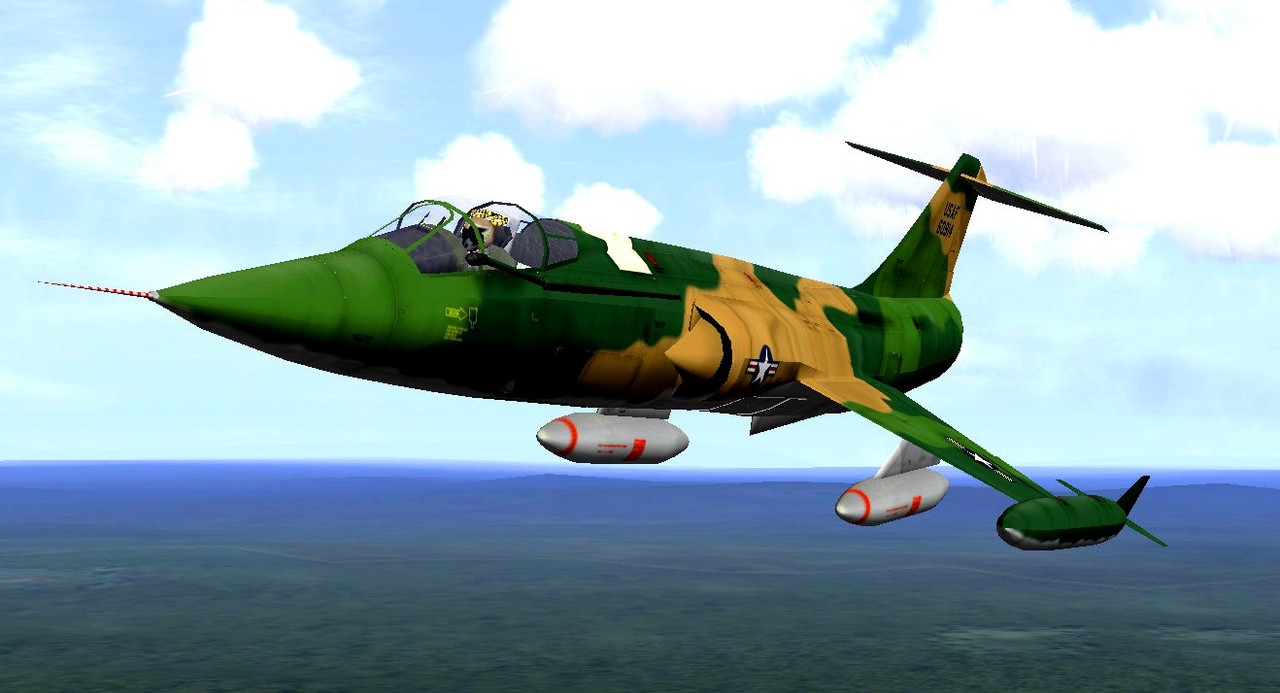
Starfighters returned to Vietnam when the 435th Tactical Fighter Squadron deployed from June 1966 until July 1967, in which time they flew a further 2,269 combat sorties, for a total of 5,206 sorties. Nine more F-104s were lost. The Starfighter units transitioned to F-4 Phantoms in July 1967, having lost a total of 14 F-104s to all causes in Vietnam. F-104s operating in Vietnam were upgraded in service with APR-25/26 radar warning receiver equipment, and one example is on display in the Air Zoo in Kalamazoo, Michigan.
The introduction of a highly technical aircraft type to a newly reformed air force was fraught with problems. Many pilots and ground crew had settled into civilian jobs after World War II and had not kept pace with developments, with pilots being sent on short "refresher" courses in slow and benign-handling first generation jet aircraft. Ground crew were similarly employed with minimal training and experience, which was one consequence of a conscripted military with a high turnover of service personnel. Operating in poor northwest European weather conditions (vastly unlike the fair weather training conditions at Luke AFB in Arizona) and flying at high speed and low level over hilly terrain, a great many accidents were attributed to controlled flight into terrain (CFIT). German Air Force and German Navy losses totaled 110 pilots, around half of them Naval Officers.
One contributing factor to this was the operational assignment of the F-104 in German service: it was mainly intended for the fighter-bomber use, as opposed to the original design of a high-speed, high-altitude fighter/interceptor. This not only meant providing for the usual low-level missions, but also led to the installation of additional avionic equipment in the F-104G version, such as the inertial navigation system, the additional weight of which hampered the flying abilities of the plane even further and was said to add far more distraction to the pilot. In contemporary German magazine articles highlighting the Starfighter safety problems the aircraft was portrayed as "overburdened" with technology, which was considered a latent overstrain on the aircrews.
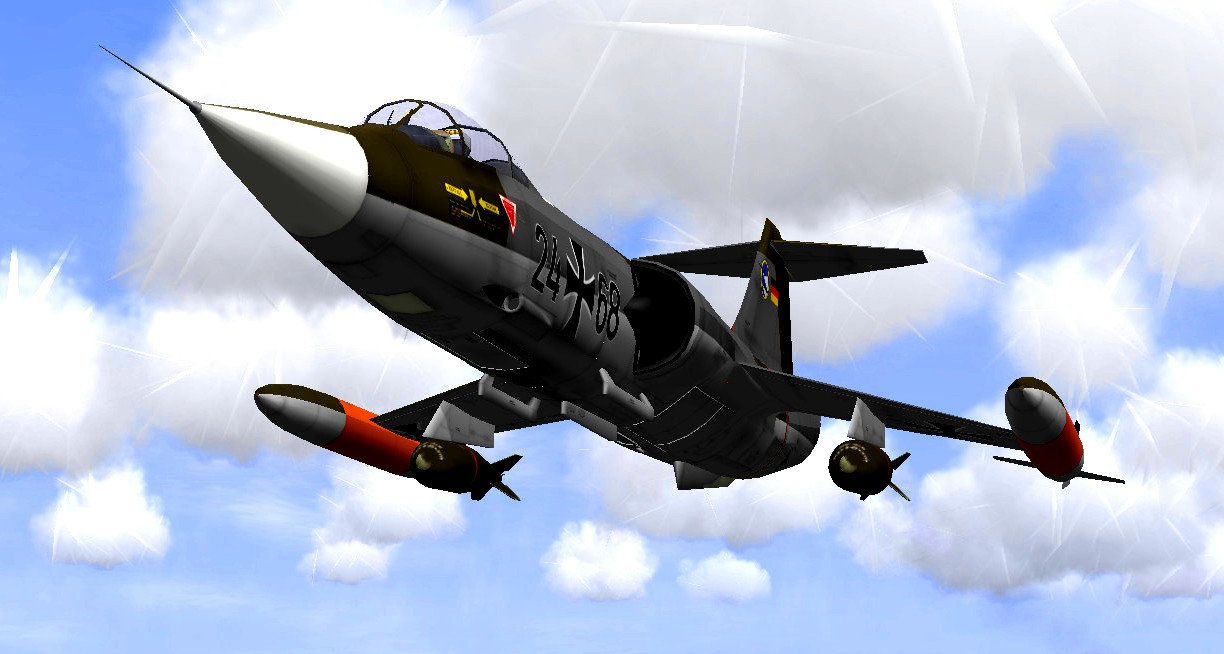
In 1966 Johannes Steinhoff took over command of the Luftwaffe and grounded the entire Luftwaffe and Bundesmarine F-104 fleet until he was satisfied that problems had been resolved or at least reduced. In later years, the German safety record improved, although a new problem of structural failure of the wings emerged. Original fatigue calculations had not taken into account the high number of g-force loading cycles that the German F-104 fleet was experiencing, and many airframes were returned for depot maintenance where their wings were replaced, while other aircraft were simply retired. Towards the end of Luftwaffe service, some aircraft were modified to carry a flight data recorder or "black box" which could give an indication of the probable cause of an accident. Erich Hartmann, the world's top-scoring fighter ace, commanded one of Germany's first (post-war) jet fighter-equipped squadrons and deemed the F-104 to be an unsafe aircraft with poor handling characteristics for aerial combat. In Navy service it lacked the safety margin of a twin engine design like the Blackburn Buccaneer. To the dismay of his superiors, Hartmann judged the fighter unfit for Luftwaffe use even before its introduction.
246 Italian versions were produced by FIAT (one aircraft crashed prior to delivery and is often not included in the total number built). Forty aircraft were delivered to the Turkish Air Force and the rest to the Italian Air Force (Aeronautica Militare Italiana). The F-104S was upgraded for the interception role having NASARR R-21G/H radar with moving-target indicator and continuous-wave illuminator for SARH missiles (initially AIM-7 Sparrow), two additional wing and two underbelly hardpoints (increasing the total to nine), more powerful J79-GE-19 engine with 11,870 lbf (53 kN) and 17,900 lbf (80 kN) thrust, and two additional ventral fins to increase stability. The M61 cannon was sacrificed to make room for the missile avionics in the interceptor version but retained for the fighter-bomber variants. Up to two Sparrow; and two, theoretically four or six Sidewinder missiles were carried on all the hardpoints except the central (underbelly), or seven 750 lb (340 kg) bombs (normally two–four 500–750 lb/227–340 kg). The F-104S was cleared for a higher maximum takeoff weight, allowing it to carry up to 7,500 lb (3,400 kg) of stores; other Starfighters had a maximum external load of 4,000 lb (1,814 kg). Range was up to 780 mi (1,250 km) with four tanks.

F-104S-ASA/M(Aggiornamento Sistemi d'Arma/Modificato – "Weapon Systems Update/Modified") – 49 airframes upgraded in 1998 to ASA/M standard with GPS, new TACAN and Litton LN-30A2 INS, refurbished airframe, improved cockpit displays. All strike-related equipment was removed. The last Starfighters in combat service, they were withdrawn in December 2004 and temporarily replaced by the F-16 Fighting Falcon, while awaiting Eurofighter Typhoon deliveries.
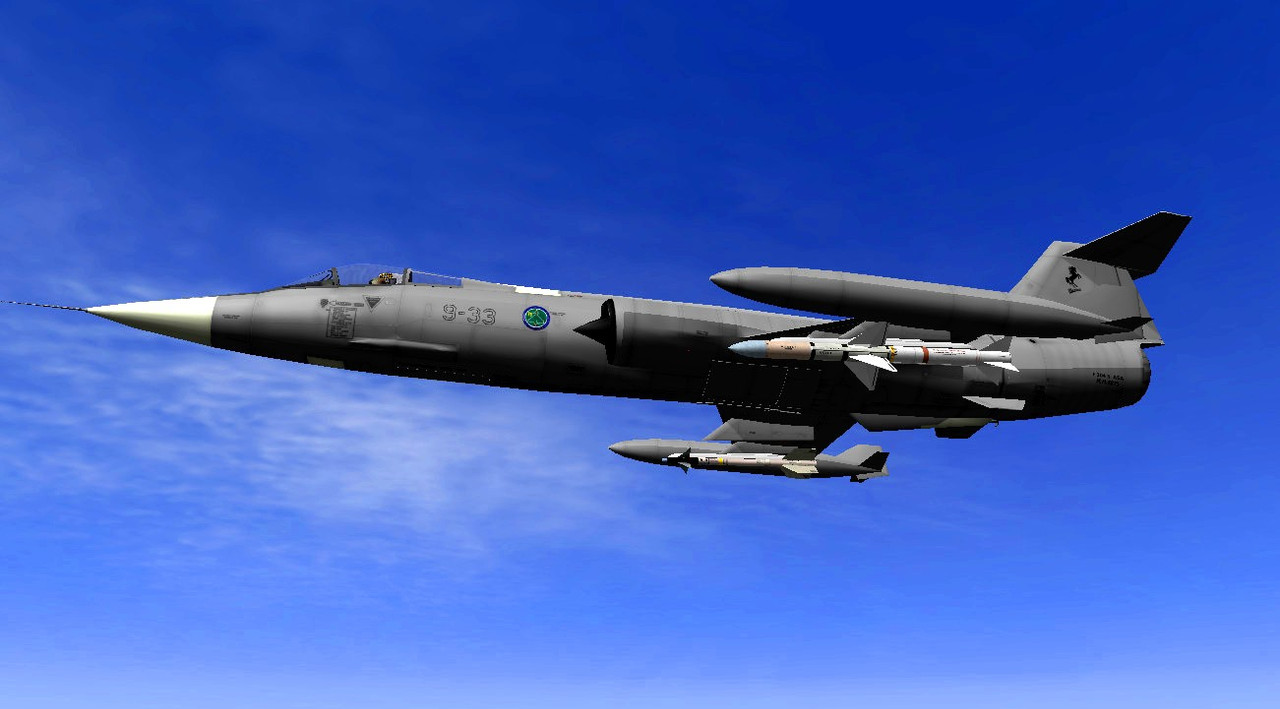
200 Canadian-built versions, built under license by Canadair and optimized for both nuclear strike and 2-stage-to-orbit payload delivery, having NASARR R-24A radar with air-to-air modes, cannon deleted (restored after 1972), additional internal fuel cell, and Canadian J79-OEL-7 engines with 10,000 lbf (44 kN)/15,800 lbf (70 kN) thrust.
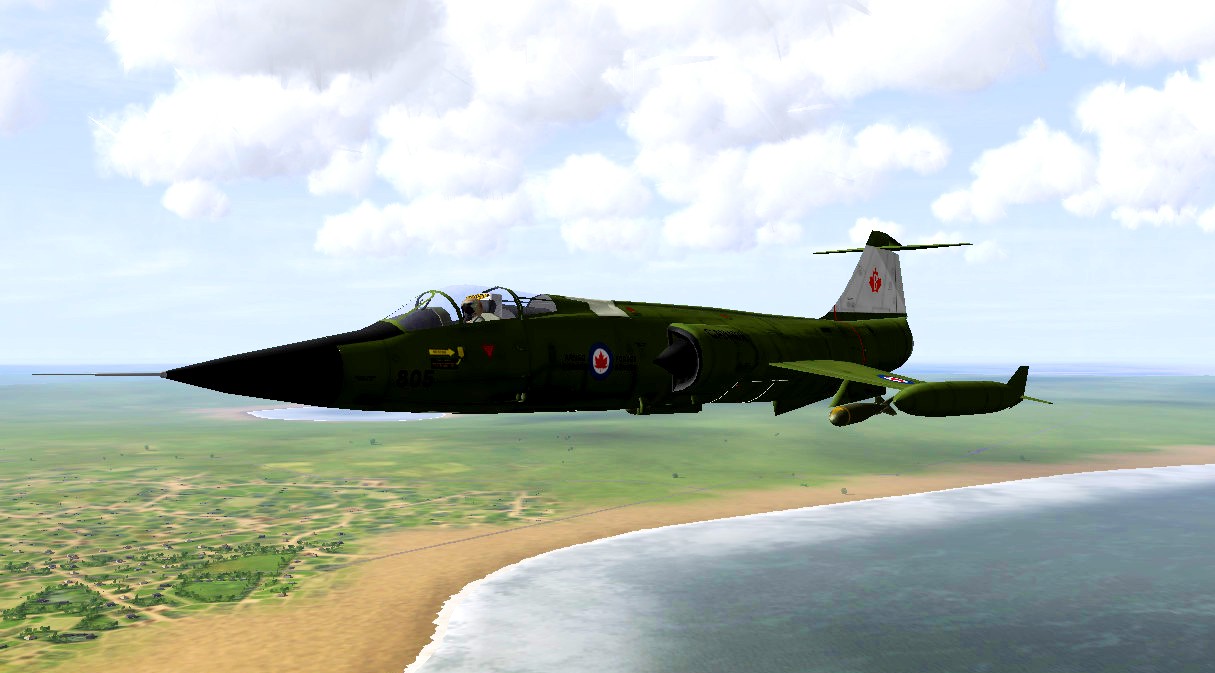
The F-104J was a specialized interceptor version of the F-104G for the Japanese ASDF, built under license by Mitsubishi for the air-superiority fighter role, armed with cannon and four Sidewinders; no strike capability. Some were converted to UF-104J radio-controlled target drones and destroyed. Total of 210 built, three built by Lockheed, 29 built by Mitsubushi from Lockheed built components and 178 built by Mitsubishi
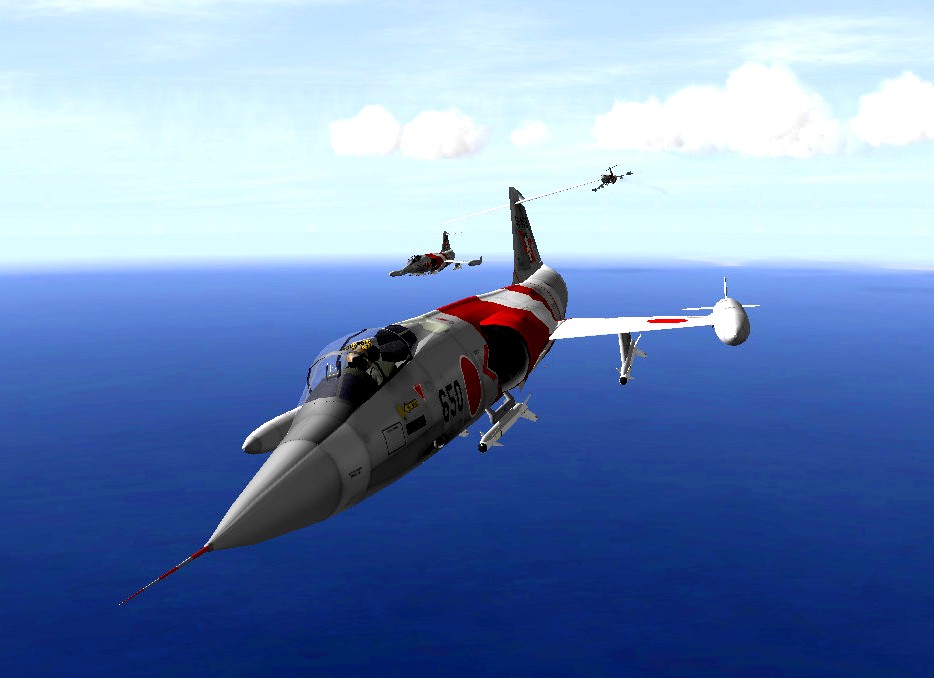
The F-104C version loads all the bombs used by the USAF in the 1960s, while the G and S variants use the NATO conversion of American weapons.
All versions with Air/Ground configuration also have the bombs of the Mk series.
The F-104G can load the AS.34 anti ship missile, the F-104 ASA-M has the Aspide missile, with the better efficiency as the AIM-7M except for smaller radius, due to the 104 radar.
The F-104A of 319th FIS was a special version, these planes used the same engine of the F-104S on the lightweight F-104A airframe.
In interceptor configuration, with 2 missiles and 100% fuel, are able to climb to 11000 meters in less than 90sec from the release of the brakes and to fly level at over 21000m for a short time.
For all variants the continous max top speed is mach between mach 2.1 and 2.2, but the fastest (S and A 319th) can reach mach 2.4 in overheating.
The plane is very fast also without afterburner, with poor stores can pass mach 1 and can go in a sort of supercruise for several km after reach an high supersonic speed using the AB and turning off it.
Using this tactic the Italian 104s flew from Turin to Rome in less than 20 minutes.
1.2*
- The new CF-104 have airborne radar R-24.
- CF-104 late have M-61 cannon
& new CRV7 rocketsair.ini
F-104A air.F_104A NOINFO usa01 SUMMER
F-104A_319 air.F_104A319 NOINFO usa01 SUMMER
F-104C air.F_104C NOINFO usa01 SUMMER
F-104G air.F_104G NOINFO usa01 SUMMER
CF-104 air.CF_104 NOINFO usa01 SUMMER
CF-104_Late air.CF_104L NOINFO usa01 SUMMER
F-104J air.F_104J NOINFO usa01 SUMMER
F-104S air.F_104S NOINFO usa01 SUMMER
F-104ASA air.F_104ASA NOINFO usa01 SUMMER
plane
F-104A F-104A, Starfighter 1958
F-104A_319 F-104A 319th FIS, Starfighter 1967
F-104C F-104C, Starfighter 1959
F-104G F-104G, Starfighter 1963
F-104J F-104J, Starfighter 1962
CF-104 CF-104, Starfighter 1962
CF-104_Late CF-104, Starfighter 1972
F-104S F-104S, Starfighter 1969
F-104ASA F-104S ASA-M, Starfighter 1998
Credits
Gio963tto: 3d works
mm: default skins
Western: weapons
Dreamk: weapons
Benitomuso: FM debug tools
Vega: FM and Java
Gunsight from strangelove

https://www.mediafire.com/file/hb12h7m1ifieryf/F86_NEW_GUNSIGHT.rar
TO RUN THIS MOD YOU NEED:
JET ERA
https://www.sas1946.com/main/index.php/topic,15649.0.htmlCOMMON UTILS
https://www.sas1946.com/main/index.php?topic=40490.0WEAPONS PACK VER. 1.3https://www.sas1946.com/main/index.php/topic,48603.0.htmlSAS Engine MOD western Full-pack https://www.sas1946.com/main/index.php/topic,52489.0.htmlLAST WESTERN WEAPONS PACKhttps://www.sas1946.com/main/index.php/topic,53426.0.htmlAIR GROUND ORDNANCE PACK BY DREAMKhttps://www.sas1946.com/main/index.php/topic,55355.0.htmlDownload link
https://www.mediafire.com/file/qszwdz5syyks3uu/F-104_V1.5_20180908.rar/fileSkin by Fly!
https://www.mediafire.com/?sznax0vbwlkbjuiSkins by mm
http://www.mi-psi.eu/cs/f-104.html
 Author
Topic: F-104 Starfighter by gio963tto - V 1.5 - 20180908 (Read 50791 times)
Author
Topic: F-104 Starfighter by gio963tto - V 1.5 - 20180908 (Read 50791 times)


